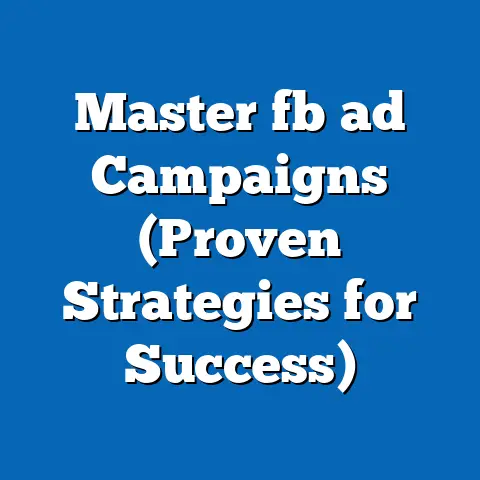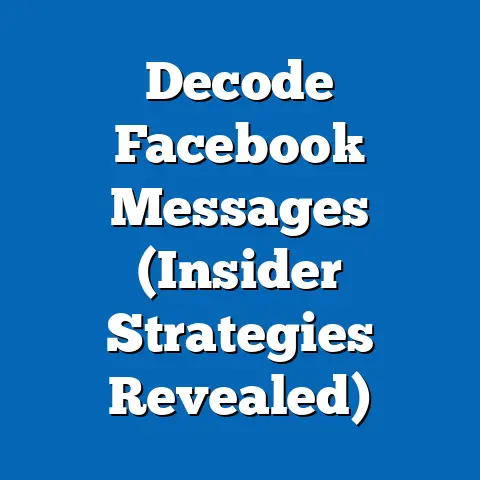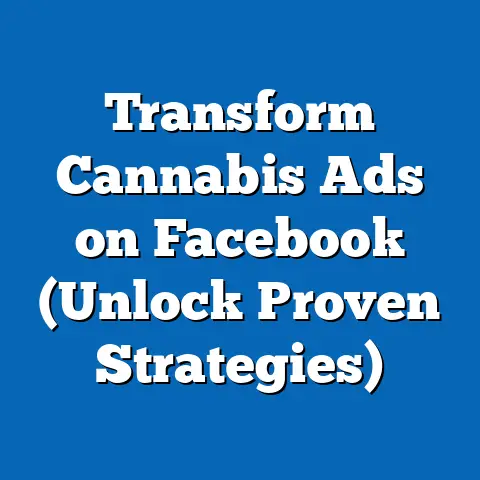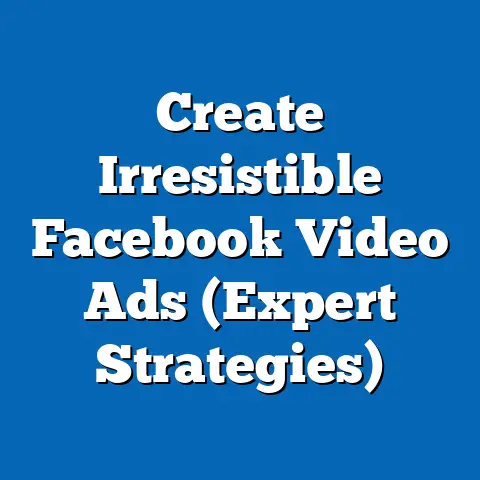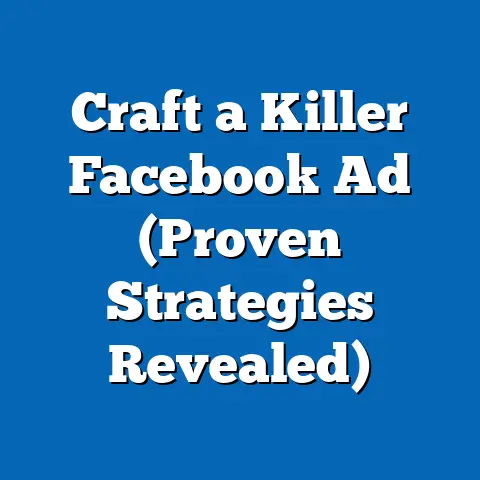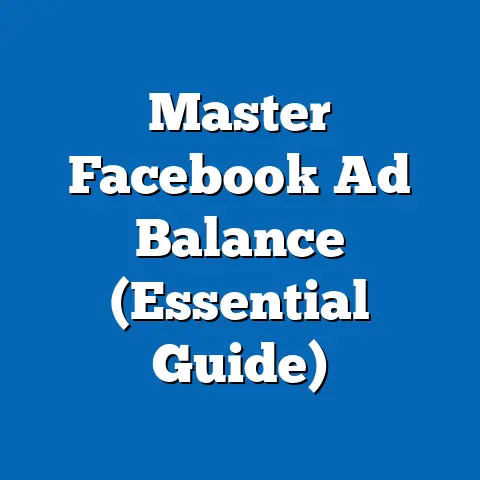Maximize Facebook Network Ads for Success (Proven Strategies)
Life in the 21st century often feels like a frantic juggling act. Whether you’re a solopreneur, a marketing manager at a growing startup, or the CEO of a large corporation, you’re constantly balancing multiple responsibilities. Between emails, meetings, projects, and, let’s face it, trying to maintain some semblance of a personal life, finding time for effective advertising can feel like an impossible task.
I remember when I first started running Facebook ads for my own small business. I was overwhelmed by the options, the data, and the constant feeling that I was missing something. I spent hours tweaking campaigns, poring over reports, and still felt like I was throwing money into a black hole. It was exhausting!
That’s why efficient marketing strategies are more critical than ever. In a world saturated with information and distractions, businesses need tools that can cut through the noise and reach their target audience without demanding every waking moment. And that’s where Facebook Network Ads come in.
Facebook Network Ads, when wielded effectively, can be a game-changer. They offer a powerful way to streamline your advertising efforts, allowing you to connect with potential customers across a vast network of platforms without overwhelming your already packed schedule. It’s about working smarter, not harder.
Understanding Facebook Network Ads
Facebook Network Ads aren’t just about posting an ad on Facebook and hoping for the best. They represent a sophisticated ecosystem that leverages the immense reach of Facebook and its associated platforms, including Instagram, Messenger, and the Audience Network. To truly maximize their potential, it’s crucial to understand the key components that make them tick.
Let’s break down the key components:
- Audience Targeting: This is the heart of Facebook advertising. Facebook boasts incredibly granular targeting options, allowing you to reach users based on demographics (age, gender, location), interests (hobbies, pages they’ve liked), behaviors (purchase history, online activity), and connections (friends of people who like your page). I’ve seen campaigns go from zero to hero simply by refining the audience targeting. One time, I was running ads for a local coffee shop, and initially, the results were lackluster. But after diving deeper into the audience insights and targeting people who were interested in “local coffee,” “organic food,” and “sustainable living,” the ad performance skyrocketed.
- Ad Placements: Where your ad appears matters. You can choose manual placements, selecting specific platforms and locations within those platforms (e.g., Facebook News Feed, Instagram Stories), or you can opt for automatic placements, allowing Facebook’s algorithm to determine the best placement based on your campaign objectives and budget. I usually recommend starting with automatic placements to let Facebook learn which placements perform best, and then refining your strategy based on the data.
- Ad Formats: Facebook offers a wide range of ad formats, including single image ads, video ads, carousel ads (allowing users to scroll through multiple images or videos), collection ads (showcasing a product catalog), and lead generation ads (collecting user information directly within the ad). The best format depends on your objective and the type of content you want to share. For example, if you’re selling a physical product, a carousel ad showcasing different angles and features might be more effective than a single image ad.
Understanding Facebook’s algorithms is also paramount. These algorithms are constantly evolving, learning from user behavior and adapting to optimize ad delivery. The more you understand how these algorithms work, the better you can craft campaigns that align with their goals and increase your chances of success. For example, Facebook prioritizes ads that are engaging and relevant to users. So, creating high-quality content that resonates with your target audience is crucial.
The Power of Facebook: Statistics Don’t Lie
The potential reach and effectiveness of Facebook Network Ads are undeniable. Consider these statistics:
- As of Q4 2023, Facebook boasts over 3 billion monthly active users. (Source: Meta Investor Relations)
- Instagram has over 2 billion monthly active users. (Source: Statista)
- The average Facebook user spends approximately 30 minutes per day on the platform. (Source: Statista)
These numbers underscore the immense potential audience you can reach through Facebook Network Ads. Compared to other advertising platforms, Facebook offers unparalleled targeting capabilities, a vast user base, and a wide range of ad formats, making it a powerful tool for businesses of all sizes.
Key Takeaway: Facebook Network Ads are a powerful ecosystem that leverages the reach of Facebook, Instagram, Messenger, and the Audience Network. Understanding the key components – audience targeting, ad placements, and ad formats – is crucial for crafting successful campaigns. Understanding Facebook’s algorithms and user behavior is equally important.
Next Steps: Familiarize yourself with Facebook Ads Manager and explore the different targeting options and ad formats available. Start small, experiment, and track your results.
Setting Clear Objectives
Imagine setting out on a road trip without knowing your destination. You might enjoy the scenery for a while, but eventually, you’ll feel lost and directionless. The same principle applies to Facebook ad campaigns. Without clear, measurable objectives, you’re essentially wandering aimlessly, wasting time and money.
Setting clear objectives is absolutely vital for any Facebook ad campaign. It provides a roadmap for your efforts, helps you measure success, and allows you to optimize your campaigns for better results. Before you even think about creating an ad, you need to define what you want to achieve.
Facebook Ads Manager offers a range of objectives, broadly categorized into three stages:
- Awareness: These objectives focus on increasing brand visibility and reach. They’re ideal for introducing your brand to a new audience or creating buzz around a new product or service. Common awareness objectives include:
- Brand Awareness: Show your ad to people who are most likely to remember it.
- Reach: Show your ad to the maximum number of people in your target audience.
- Consideration: These objectives aim to drive engagement and interest in your brand. They encourage users to learn more about your products or services and consider making a purchase. Common consideration objectives include:
- Traffic: Drive traffic to your website or landing page.
- Engagement: Increase likes, comments, shares, and other forms of engagement on your ad.
- App Installs: Encourage users to download your mobile app.
- Video Views: Increase the number of views on your video ad.
- Lead Generation: Collect leads directly within Facebook through a lead form.
- Messages: Encourage users to contact you through Messenger.
- Conversion: These objectives focus on driving specific actions that lead to sales or other desired outcomes. They’re ideal for converting leads into customers and maximizing your return on investment. Common conversion objectives include:
- Conversions: Track conversions on your website or app, such as purchases, sign-ups, or form submissions.
- Catalog Sales: Promote products from your product catalog to users who are likely to purchase them.
- Store Traffic: Drive traffic to your physical store.
- Brand Awareness: Show your ad to people who are most likely to remember it.
- Reach: Show your ad to the maximum number of people in your target audience.
- Traffic: Drive traffic to your website or landing page.
- Engagement: Increase likes, comments, shares, and other forms of engagement on your ad.
- App Installs: Encourage users to download your mobile app.
- Video Views: Increase the number of views on your video ad.
- Lead Generation: Collect leads directly within Facebook through a lead form.
- Messages: Encourage users to contact you through Messenger.
- Conversions: Track conversions on your website or app, such as purchases, sign-ups, or form submissions.
- Catalog Sales: Promote products from your product catalog to users who are likely to purchase them.
- Store Traffic: Drive traffic to your physical store.
Aligning Objectives with Your Marketing Strategy
Your Facebook ad objectives should always align with your overall marketing strategy. Consider your business goals and how Facebook ads can help you achieve them. For example, if your goal is to increase brand awareness, you might focus on reach and engagement objectives. If your goal is to drive sales, you might focus on conversions and catalog sales objectives.
Here’s how businesses can align their objectives with their overall marketing strategy:
- Assess Your Current Business Goals: What are you trying to achieve as a business? Are you trying to increase sales, generate leads, build brand awareness, or something else?
- Identify Your Target Audience: Who are you trying to reach with your ads? What are their demographics, interests, and behaviors?
- Choose the Right Objectives: Based on your business goals and target audience, select the Facebook ad objectives that are most likely to help you achieve your desired outcomes.
- Set Measurable Goals: Define specific, measurable, achievable, relevant, and time-bound (SMART) goals for your campaigns. For example, instead of saying “increase brand awareness,” say “increase brand awareness by 20% in the next quarter.”
- Track Your Results: Monitor your campaign performance closely and track your progress towards your goals. Use the data to optimize your campaigns and improve your results.
Tips for Assessing Business Goals and Translating Them into Ad Objectives
- Start with the end in mind: What is the ultimate outcome you want to achieve? Work backward from there to determine the steps you need to take to reach your goal.
- Consider your sales funnel: Where are your customers in the sales funnel? Are they just learning about your brand, or are they ready to make a purchase? Choose objectives that are appropriate for their stage in the funnel.
- Don’t be afraid to experiment: Try different objectives and see which ones work best for your business.
- Use data to guide your decisions: Track your campaign performance closely and use the data to optimize your objectives and strategies.
I’ve seen firsthand the impact of well-defined objectives. I once worked with a local bakery that wanted to increase its online orders. Initially, they were running a general brand awareness campaign, but the results were underwhelming. After we switched to a conversion objective and targeted users who had previously visited their website, online orders increased by 40% in just one month.
Key Takeaway: Setting clear, measurable objectives is crucial for the success of your Facebook ad campaigns. Choose objectives that align with your overall marketing strategy and set SMART goals to track your progress.
Next Steps: Review your current business goals and identify the Facebook ad objectives that are most likely to help you achieve them. Set SMART goals for your campaigns and track your results closely.
Crafting Compelling Ad Content
You’ve nailed down your objectives and targeted the perfect audience. Now comes the crucial part: crafting ad content that grabs attention, resonates with your target audience, and compels them to take action. In today’s crowded digital landscape, where users are bombarded with ads from every direction, creating compelling ad content is more important than ever.
Think of your ad as a conversation starter. You have a few seconds to capture someone’s attention and convince them to listen to what you have to say. If your ad is boring, irrelevant, or confusing, they’ll simply scroll past it.
Here are the essential elements of creating compelling ad content:
- Engaging Visuals: In the visual world of social media, your ad’s image or video is often the first thing people see. It needs to be eye-catching, relevant, and high-quality.
- High-Quality Images: Use professional-looking images that are clear, well-lit, and visually appealing. Avoid blurry or pixelated images.
- Compelling Videos: Create short, engaging videos that tell a story and capture attention. Use captions and visuals to convey your message even if users have the sound turned off.
- Brand Consistency: Maintain a consistent visual style across all your ads to reinforce your brand identity.
- Concise Messaging: Get straight to the point and communicate your message clearly and concisely.
- Headline: Your headline should be attention-grabbing and clearly communicate the value proposition of your ad.
- Body Text: Keep your body text short and sweet. Highlight the key benefits of your product or service and explain why users should take action.
- Use Power Words: Incorporate power words that evoke emotion and encourage action, such as “free,” “new,” “exclusive,” and “limited time.”
- Strong Calls to Action (CTAs): Tell users exactly what you want them to do.
- Clear and Concise CTAs: Use clear and concise CTAs that leave no room for ambiguity. Examples include “Shop Now,” “Learn More,” “Sign Up,” and “Get Started.”
- Urgency: Create a sense of urgency by using phrases like “Limited Time Offer” or “Sale Ends Soon.”
- Placement: Make sure your CTA is prominently displayed and easy to find.
- High-Quality Images: Use professional-looking images that are clear, well-lit, and visually appealing. Avoid blurry or pixelated images.
- Compelling Videos: Create short, engaging videos that tell a story and capture attention. Use captions and visuals to convey your message even if users have the sound turned off.
- Brand Consistency: Maintain a consistent visual style across all your ads to reinforce your brand identity.
- Headline: Your headline should be attention-grabbing and clearly communicate the value proposition of your ad.
- Body Text: Keep your body text short and sweet. Highlight the key benefits of your product or service and explain why users should take action.
- Use Power Words: Incorporate power words that evoke emotion and encourage action, such as “free,” “new,” “exclusive,” and “limited time.”
- Clear and Concise CTAs: Use clear and concise CTAs that leave no room for ambiguity. Examples include “Shop Now,” “Learn More,” “Sign Up,” and “Get Started.”
- Urgency: Create a sense of urgency by using phrases like “Limited Time Offer” or “Sale Ends Soon.”
- Placement: Make sure your CTA is prominently displayed and easy to find.
Examples of Successful Ad Campaigns
One campaign that always sticks in my mind is Dollar Shave Club. Their early video ads were hilarious, irreverent, and completely memorable. They didn’t just show off their product; they told a story and created a brand personality that resonated with their target audience. The key takeaway? Don’t be afraid to be creative and stand out from the crowd.
Another great example is Airbnb. They often use stunning photography and compelling storytelling to showcase unique travel experiences. Their ads don’t just sell a place to stay; they sell a dream.
A/B Testing: The Key to Refining Your Ad Content
Creating compelling ad content is an iterative process. What works today might not work tomorrow. That’s why A/B testing is so important. A/B testing involves creating multiple versions of your ad with slight variations and then testing them against each other to see which one performs best.
Here are some elements you can A/B test:
- Headline: Try different headlines to see which one attracts the most clicks.
- Image/Video: Test different images or videos to see which one resonates best with your audience.
- Body Text: Experiment with different wording and messaging.
- Call to Action: Try different CTAs to see which one drives the most conversions.
- Audience Targeting: Test different audience segments to see which one is most responsive to your ads.
I remember working with a clothing retailer that was struggling to generate sales from their Facebook ads. We started A/B testing different ad creatives, focusing on the image and the headline. After several rounds of testing, we discovered that images featuring real people wearing their clothes performed significantly better than product shots. We also found that headlines that emphasized the “comfort” and “quality” of their clothes resonated more with their target audience. As a result, their sales increased by 30%.
Key Takeaway: Compelling ad content is essential for capturing attention, resonating with your target audience, and driving results. Use engaging visuals, concise messaging, and strong calls to action. A/B test your ad content regularly to optimize your performance.
Next Steps: Review your current ad content and identify areas for improvement. Start A/B testing different elements to see which ones perform best.
Targeting the Right Audience
Imagine you’re trying to sell snow shovels in Miami. No matter how compelling your ad copy or how visually stunning your images, you’re unlikely to generate many sales because you’re targeting the wrong audience. Targeting the right audience is just as crucial as crafting compelling ad content. In fact, it’s arguably even more important.
Facebook Ads Manager offers a wealth of targeting options, allowing you to reach specific groups of people based on their demographics, interests, behaviors, and connections. Mastering these targeting options is essential for maximizing the effectiveness of your ad campaigns.
Here’s a breakdown of the key targeting options:
- Demographic Targeting: Target users based on age, gender, location, education, relationship status, job title, and other demographic factors.
- Interest Targeting: Target users based on their interests, hobbies, and the pages they’ve liked on Facebook.
- Behavioral Targeting: Target users based on their online behavior, purchase history, and other activities.
- Connection Targeting: Target users based on their connections to your Facebook page, events, or apps.
- Custom Audiences: Create custom audiences based on your existing customer data, such as email lists, website visitors, or app users.
- Lookalike Audiences: Create lookalike audiences based on your custom audiences. Facebook will identify users who share similar characteristics and behaviors with your existing customers.
Creating Custom Audiences
Custom audiences are a powerful tool for reaching your existing customers and prospects. You can create custom audiences based on a variety of sources, including:
- Customer List: Upload a list of customer email addresses or phone numbers. Facebook will match these contacts with users on its platform.
- Website Traffic: Target users who have visited your website or specific pages on your website.
- App Activity: Target users who have installed your mobile app or taken specific actions within your app.
- Engagement: Target users who have engaged with your Facebook page, ads, or videos.
Expanding Reach with Lookalike Audiences
Lookalike audiences are a great way to expand your reach while maintaining relevance. Facebook will analyze your custom audience and identify users who share similar characteristics and behaviors. You can specify the size of your lookalike audience, ranging from 1% to 10% of the total population in a given country. A smaller percentage will result in a more targeted audience, while a larger percentage will result in a broader audience.
Actionable Tips for Audience Research
- Start with your ideal customer: Who is your ideal customer? What are their demographics, interests, and behaviors?
- Analyze your existing customer data: Look for patterns and trends in your customer data. What are their common demographics, interests, and behaviors?
- Use Facebook Audience Insights: Facebook Audience Insights is a powerful tool for researching your target audience. It provides valuable data on their demographics, interests, behaviors, and more.
- Experiment with different targeting options: Don’t be afraid to experiment with different targeting options to see which ones perform best.
- Monitor your campaign performance: Track your campaign performance closely and adjust your targeting based on the data.
I once worked with a local bookstore that wanted to increase its online sales. We started by creating a custom audience based on their email list of existing customers. Then, we created a lookalike audience based on that custom audience. We targeted both audiences with ads promoting their online store, and the results were phenomenal. Their online sales increased by 50% in just one month.
Key Takeaway: Targeting the right audience is crucial for the success of your Facebook ad campaigns. Utilize the various targeting options available in Facebook Ads Manager to reach specific groups of people based on their demographics, interests, behaviors, and connections. Create custom audiences and lookalike audiences to expand your reach while maintaining relevance.
Next Steps: Conduct thorough audience research to identify your ideal customer. Create custom audiences based on your existing customer data and experiment with lookalike audiences to expand your reach.
Optimizing Ad Campaigns
You’ve created compelling ad content, targeted the right audience, and launched your Facebook ad campaign. But your work isn’t done yet. In fact, it’s just beginning. Monitoring and optimizing your ad campaigns is an ongoing process that’s essential for maximizing your return on investment.
Think of your ad campaign as a living, breathing organism. It needs constant attention and care to thrive. You need to monitor its performance, identify areas for improvement, and make adjustments accordingly.
Here are the key performance indicators (KPIs) you should be tracking:
- Click-Through Rate (CTR): The percentage of people who click on your ad after seeing it. A high CTR indicates that your ad is relevant and engaging.
- Cost Per Click (CPC): The amount you pay each time someone clicks on your ad. A low CPC indicates that your ad is efficient and cost-effective.
- Conversion Rate: The percentage of people who take a desired action after clicking on your ad, such as making a purchase, signing up for a newsletter, or filling out a form. A high conversion rate indicates that your ad is effective at driving results.
- Cost Per Acquisition (CPA): The amount you pay for each conversion. A low CPA indicates that your ad is efficient at generating leads or sales.
- Return on Ad Spend (ROAS): The amount of revenue you generate for every dollar you spend on advertising. A high ROAS indicates that your ad is profitable.
Tools and Features within Facebook Ads Manager
Facebook Ads Manager provides a wealth of tools and features to help you track and optimize your campaigns in real-time.
- Facebook Pixel: The Facebook Pixel is a code snippet that you install on your website. It allows you to track conversions, retarget website visitors, and optimize your ads for conversions.
- Custom Columns: Customize your reporting dashboard to display the KPIs that are most important to you.
- Automated Rules: Set up automated rules to automatically adjust your bids, budgets, or ad schedules based on specific triggers.
- A/B Testing: Use A/B testing to compare different versions of your ads and identify which ones perform best.
- Campaign Budget Optimization (CBO): Allow Facebook to automatically distribute your budget across your ad sets to maximize your results.
Successful Optimization Strategies
One successful optimization strategy is to focus on improving your ad relevance score. Your ad relevance score is a metric that measures how relevant your ad is to your target audience. A high relevance score can lead to lower costs and better results.
Here are some tips for improving your ad relevance score:
- Target the right audience: Make sure you’re targeting the right audience for your ad.
- Create compelling ad content: Use engaging visuals, concise messaging, and strong calls to action.
- A/B test your ad content: Experiment with different versions of your ad to see which one performs best.
- Monitor your campaign performance: Track your campaign performance closely and adjust your targeting and ad content based on the data.
I once worked with an e-commerce business that was struggling to generate a positive ROAS from their Facebook ads. We started by analyzing their campaign data and identified that their ad relevance scores were low. We then focused on improving their ad content and targeting, and their relevance scores increased significantly. As a result, their ROAS increased by 50%.
Key Takeaway: Monitoring and optimizing your Facebook ad campaigns is an ongoing process that’s essential for maximizing your return on investment. Track key performance indicators, utilize the tools and features within Facebook Ads Manager, and implement successful optimization strategies.
Next Steps: Review your current ad campaigns and identify areas for improvement. Start tracking key performance indicators and utilize the tools and features within Facebook Ads Manager to optimize your campaigns.
Leveraging Retargeting Strategies
Imagine a potential customer visits your website, browses your products, and even adds something to their cart, but then leaves without making a purchase. This happens all the time! Retargeting allows you to reconnect with these users and remind them of your products or services, increasing the chances of them completing a purchase.
Retargeting is a powerful strategy for maximizing the effectiveness of Facebook Network Ads. It allows you to reconnect with users who have previously interacted with your brand, increasing the chances of them converting into customers.
Here’s how retargeting works:
- Install the Facebook Pixel: The Facebook Pixel tracks the actions that users take on your website, such as visiting pages, adding products to their cart, or making a purchase.
- Create a Custom Audience: Create a custom audience based on the users who have taken specific actions on your website. For example, you can create a custom audience of users who have visited your product pages but haven’t made a purchase.
- Create a Retargeting Campaign: Create a retargeting campaign that targets your custom audience with ads that are relevant to their previous interactions with your brand. For example, you can show users who added a product to their cart but didn’t purchase it an ad that reminds them of the product and offers a discount.
Setting Up Retargeting Campaigns
Setting up retargeting campaigns is relatively straightforward. Here’s a step-by-step guide:
- Install the Facebook Pixel: If you haven’t already, install the Facebook Pixel on your website.
- Create a Custom Audience: Go to Facebook Ads Manager and create a custom audience based on your website traffic.
- Create a Retargeting Campaign: Create a new campaign and select the “Conversions” objective.
- Define Your Audience: In the ad set settings, select your custom audience as the target audience.
- Create Your Ad: Create an ad that is relevant to the users in your custom audience. For example, if you’re retargeting users who added a product to their cart but didn’t purchase it, show them an ad that reminds them of the product and offers a discount.
- Set Your Budget and Schedule: Set your budget and schedule for your retargeting campaign.
- Launch Your Campaign: Launch your retargeting campaign and monitor its performance.
Best Practices for Creating Effective Retargeting Ads
- Personalize Your Ads: Use dynamic product ads to show users the exact products they viewed on your website.
- Offer Incentives: Offer discounts or free shipping to encourage users to complete a purchase.
- Create a Sense of Urgency: Use phrases like “Limited Time Offer” or “Sale Ends Soon” to create a sense of urgency.
- Use Compelling Visuals: Use high-quality images or videos to capture attention.
- Test Different Ad Creatives: A/B test different ad creatives to see which ones perform best.
Data consistently supports the effectiveness of retargeting strategies. Studies have shown that retargeting ads have a significantly higher click-through rate and conversion rate than regular ads. This is because retargeting ads are more relevant to users who have already shown an interest in your brand.
I once worked with a travel company that was struggling to convert website visitors into bookings. We implemented a retargeting strategy that targeted users who had viewed specific hotel pages but hadn’t made a booking. We showed them ads that featured the hotels they had viewed and offered a special discount. As a result, their booking conversion rate increased by 20%.
Key Takeaway: Retargeting is a powerful strategy for maximizing the effectiveness of Facebook Network Ads. It allows you to reconnect with users who have previously interacted with your brand, increasing the chances of them converting into customers.
Next Steps: Install the Facebook Pixel on your website and start creating custom audiences based on your website traffic. Create retargeting campaigns that target these audiences with relevant ads.
Conclusion
In today’s fast-paced advertising landscape, maximizing the potential of Facebook Network Ads is essential for success. By understanding the key components of Facebook advertising, setting clear objectives, crafting compelling ad content, targeting the right audience, optimizing your campaigns, and leveraging retargeting strategies, you can achieve remarkable results.
I’ve shared my personal experiences and insights throughout this guide, highlighting the importance of not just understanding the technical aspects of Facebook advertising, but also connecting with your audience on a personal level. Remember, advertising is about building relationships and providing value.
Implementing the proven strategies outlined in this article can lead to increased brand visibility, higher engagement rates, and ultimately, greater business success. It’s about working smarter, not harder, and leveraging the power of Facebook Network Ads to achieve your marketing goals.
So, take action today. Start implementing these strategies and see the difference they can make for your business.
Call to Action:
I encourage you to share your experiences with Facebook Network Ads in the comments below. What strategies have worked best for you? What challenges have you faced?
And don’t forget to implement the strategies discussed in this article. Start small, experiment, and track your results.
Stay connected for more insights and tips on effective advertising practices. Subscribe to our newsletter and follow us on social media. Let’s continue to learn and grow together in the ever-evolving world of digital marketing.

